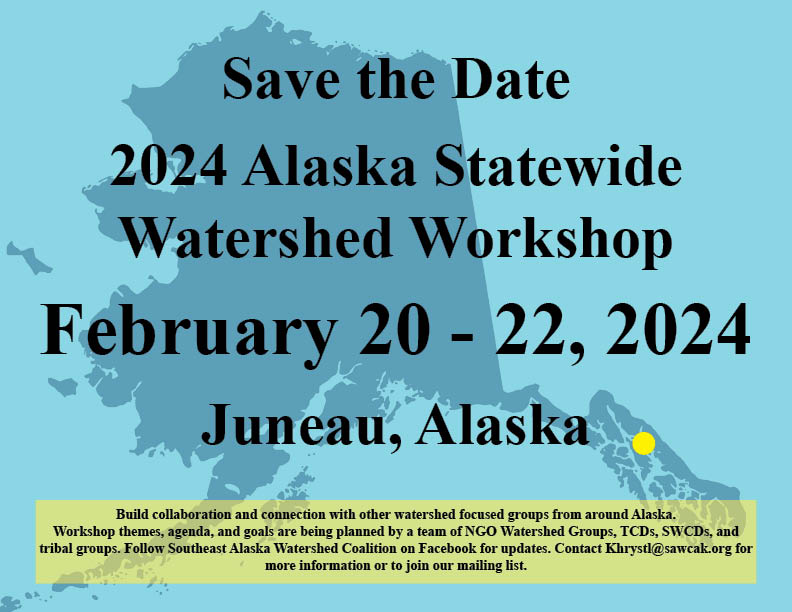
Registration is Open!!! Check out all the details here:
2024 Alaska Watershed Workshop – Connecting Partners for Connected Waters

Registration is Open!!! Check out all the details here:
2024 Alaska Watershed Workshop – Connecting Partners for Connected Waters

Southeast Alaska Watershed Workshop 2023 – Collaboration for the Future.
Overview: As the Covid pandemic fades away, we are exiting our Covid bubble into a new landscape for watershed stewardship. Agency and national leaders are promoting a new way of operating, prioritizing restoration, sustainability, community engagement, and indigenous lead Co-Stewardship. At the same time, tribes and community groups are stepping up the opportunity as existing partnerships ramp up on-the ground restoration work and new partnerships forming to fill the gaps in community led stewardship.
With this new setting, the Southeast Alaska Watershed Coalition is hosting Southeast Alaska Watershed Workshop 2023 – Co-Stewardship and Collaboration for the Future.
The event will be comprised of
1.) Short, 1-hour max webinars starting in February to help those new to watershed stewardship “level up.”
2.) 3-day workshop (March 7-9th, 2023) with interactive presentations and discussions on crosscutting themes
3.) Field training and capacity exchanges throughout summer 2023.
Webinar Details:
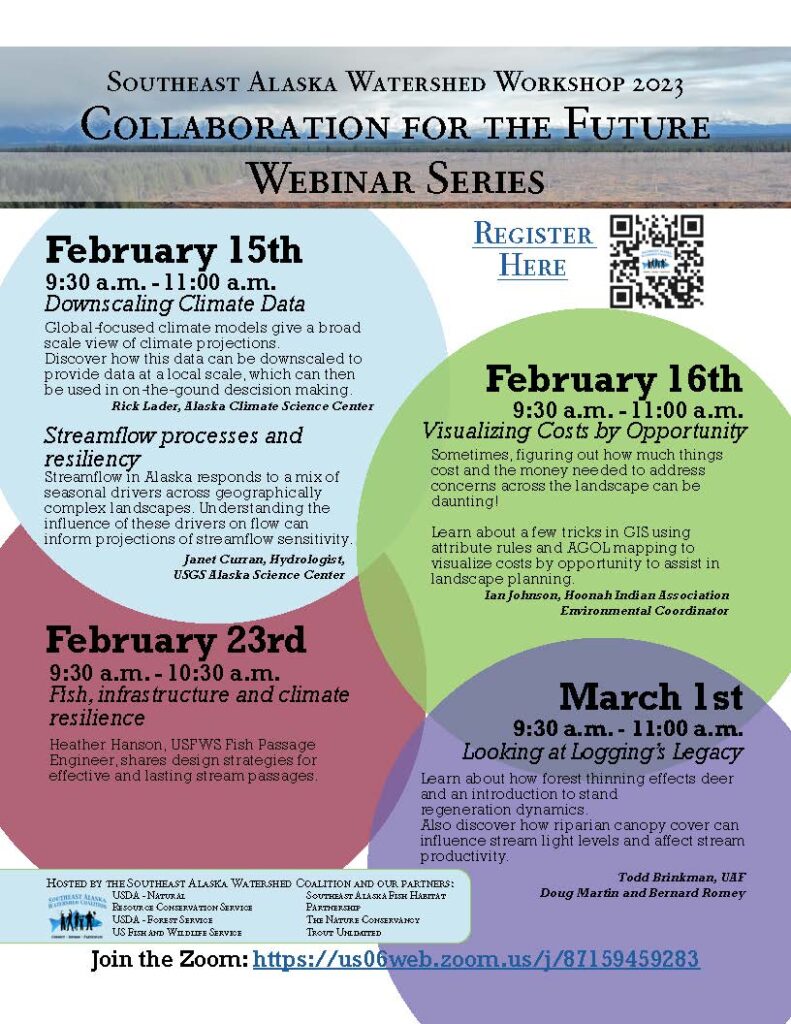
On May 21 – 2022 we celebrate the 5th World Fish Migration Day and at this point over 340 events have been registered from over 55 countries. Together with our colleagues around the world we want to save migratory fish in rivers and create real impact for the sake of rivers, fish, wildlife and people. Feel free to register an event too via www.worldfishmigrationday.com. The bigger this movement becomes the more impact we can make.
The Southeast Alaska Fish Habitat Partnership (SEAKFHP, www.seakfhp.org) and partners will be hosting many regional and local events. Including a walk across the Juneau-Douglas Bridge to raise awareness to fish friendly road-stream crossings and a virtual film festival (details are included in the attached file).
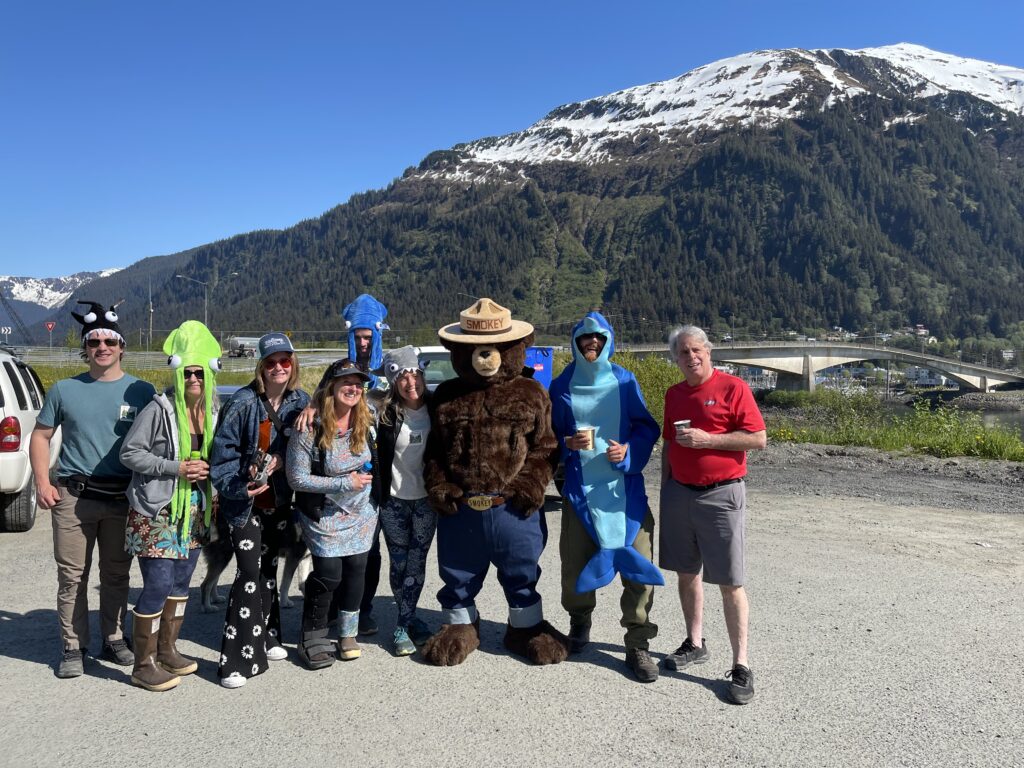
Our international partners invite you to join the BREAK FREE Live show on May 21, 2022, with guest appearance from Jeremy Wade (Host River Monsters) and Zeb Hogan (Host Monster Fish). Start: 16:30 hours and End: 18:00 hours (Central European Summertime).
REGISTER HERE FOR THE LIVE SHOW ON ZOOM: https://worldfishmigrationday.com/liveshow/
#breakfree, #stayconnected and #letitflow
On behalf of the WFMD team
Kerry Brink (Project Manager WFMD) & Herman Wanningen (Founder WFMD)
Check out the new report on the value of Alaska’s “forest fish”: Johnson et al 2019: https://www.fs.fed.us/pnw/pubs/journals/pnw_2019_johnson002.pdf
Abstract
Forested landscapes support a diversity of ecological processes and organisms having direct value to society. Assessments placing monetary value on forest processes and organisms can help inform management actions affecting these ecosystem services. The temperate rain forest ecoregion along the west coast of North America is home to five
species of Pacific salmon Oncorhynchus spp. that support subsistence, personal-use, sport, and commercial fisheries. This study aimed to quantify the number and monetary value of commercially caught Pacific salmon originating from Alaska’s Tongass and Chugach national forests, two adjacent national forests containing some of the world’s largest
remaining tracts of intact temperate rain forest. The proportion of commercially harvested wild Pacific salmon originating from streams and lakes within national forest boundaries was estimated by subtracting hatchery salmon and salmon originating outside national forest areas from the total commercial catch. The Tongass and Chugach national forests were major contributors to the overall number and value of commercially caught Pacific salmon in southeastern and southcentral Alaska. From 2007 to 2016 these national forests contributed an average of 48 million Pacific salmon annually to commercial fisheries, with a dockside value averaging US$88 million (inflation adjusted to the base year 2017). These “forest fish” represented 25% of Alaska’s commercial Pacific salmon catch for this time period and 16% of the total commercial value. These findings emphasize the importance of Alaska’s forest rivers and lakes for sustaining Pacific salmon and can contribute to discussions about alternative land management strategies that might impact Pacific salmon populations and associated commercial salmon fisheries.
This April, the Southeast Alaska Watershed Coalition and Southeast Alaska Fish Habitat Partnership teamed up to bring together over 70 participants across Alaska and the Pacific Northwest, including state and federal agencies, university researchers, Tribes, and NGOs, for a regional discussion about the state of eDNA research and existing and future applications across Alaska. The agenda, a brief meeting synopsis and the informative and valuable presentations relayed by leading researchers on the subject are available at the partnership’s website at https://seakfhp.org/edna-in-alaska-1-day-workshop-april-1-2019/.
Presentations and discussion touched on topics of interest garnered in early outreach efforts including:
Next steps include exploring capacity to support a statewide Alaska eDNA Working Group, advance opportunities to share data resources especially information about primers that exist for Alaska species, and prioritize monitoring efforts especially for aquatic invasive species detection. For more information contact the SEAKFHP coordinator at: coordinator@sealaskafishhabitat.org
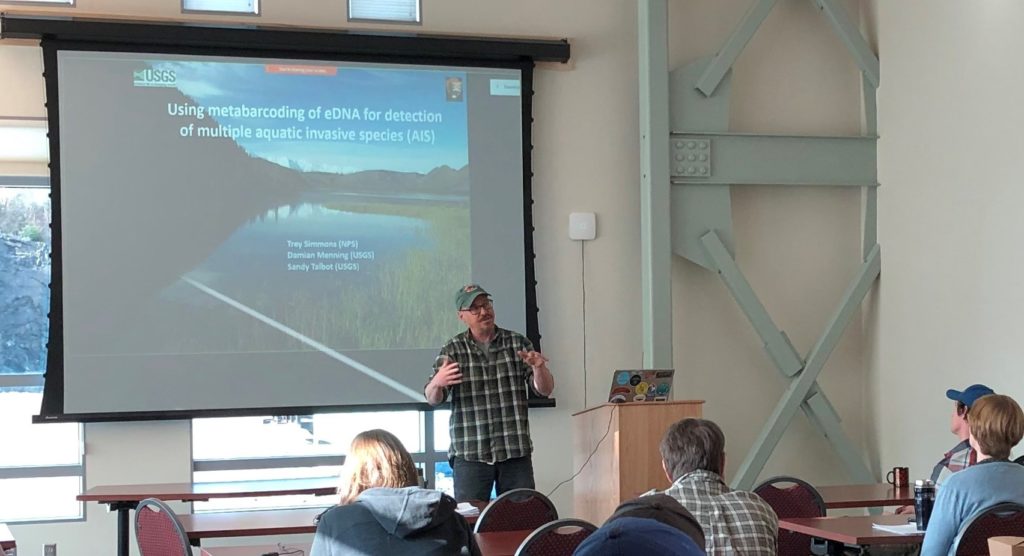
The Implementation Plan for the Southeast Alaska Freshwater Temperature Monitoring Network is now available! The Implementation Plan reviews the need for the network and long-term water temperature data, summarizes existing sites, outlines a strategic sampling plan for the future, and touches on network sustainability, including participant roles and a budget.
You can find the report on Southeast Alaska Watershed Coalition website here.
The Southeast Alaska Watershed Coalition has recently published the Wrangell Area Watershed Assessment.
The assessment can be downloaded at: http://www.alaskawatershedcoalition.org/2019/02/wrangell-area-watersheds-assessment/
The purpose of the Wrangell Area Watersheds Assessment was to compile a dataset and report outlining key aquatic resources within the City and Borough of Wrangell, including an assessment of the current habitat condition of key aquatic resources, identification of sites that could benefit from restoration treatment, and outlining watershed management challenges and opportunities.
This project was carried out with financial and technical support from the US Fish and Wildlife Service’s Coastal Program, in partnership with the Wrangell Cooperative Association, and the US Forest Service, and with financial support from the Charlotte Martin Foundation.
SAWC is greatly appreciative to all of the funders, partners, and stakeholders that helped to make this project possible.
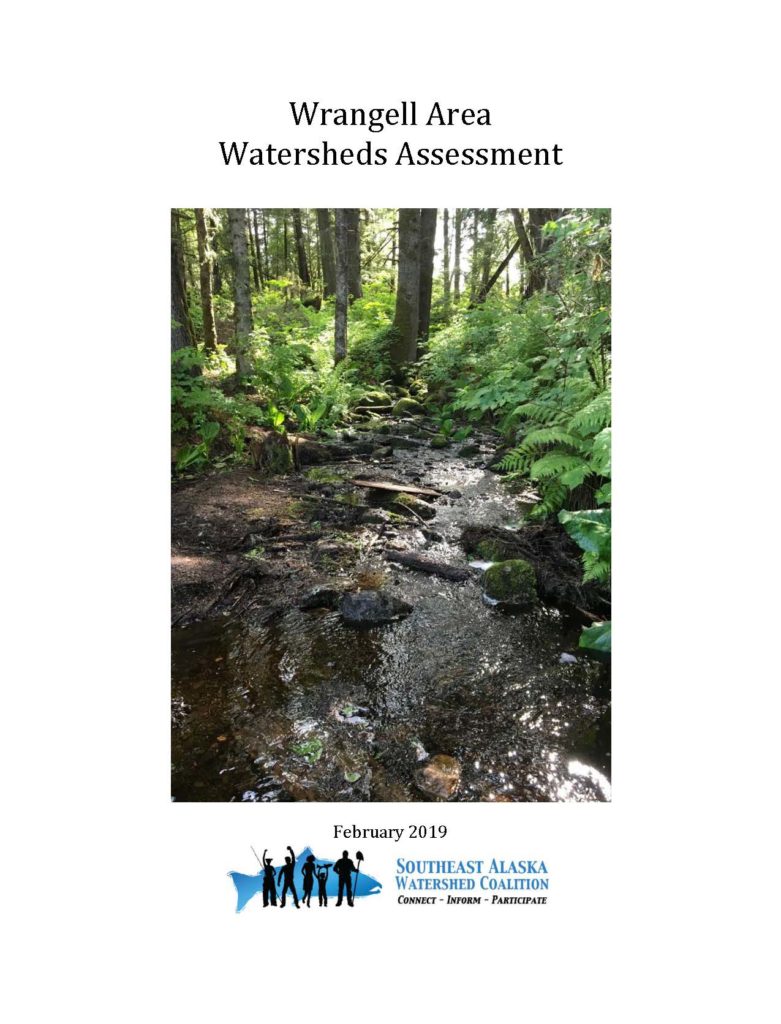
On Wednesday – February 20, 2019 scientists shared the latest on ocean acidification in Alaska including current and future conditions and species response.
Presentations were live streamed on the Alaska Ocean Observing System’s Facebook page and are now available on the Alaska Ocean Acidification Network’s web page at: https://aoos.org/alaska-ocean-acidification-network/
Presenters included:
Bob Foy, Director of NOAA Alaska Fisheries Science Center, and former director of the NOAA Kodiak Laboratory, speaking to species response to ocean acidification.
Jessica Cross, oceanographer with NOAA’s Pacific Marine Environmental Lab, studies ocean acidification across all three ocean basins in Alaska and will speak to what we know about current conditions and future scenarios.
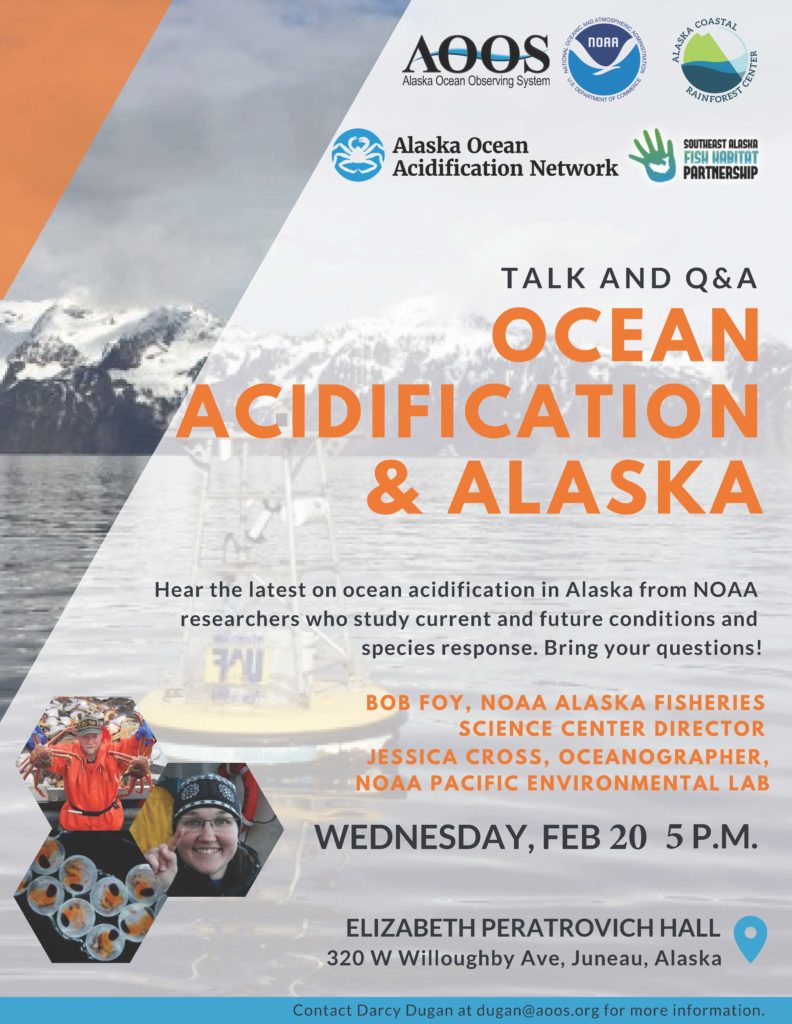
SEAKFHP’s strategic action plan includes a two-part conservation strategy one focusing on freshwater aquatic areas of Southeast Alaska and the other on coastal fish habitats. Together these components serve as a blueprint for the partnership to meet its mission with measurable objectives and actions that partners and others can use to gauge progress and success in advancing shared conservation actions. It is envisioned that by fostering regional conservation strategies, strengthening partner collaboration, elevating work accomplished and planned by partners, incorporating science-based information, and articulating key priorities shared across mixed-ownership watersheds and coastal areas throughout southeast, the partnership will achieve improved on-the-ground fish habitat conservation outcomes across the region.
The freshwater strategy relies heavily on previous partnership efforts and takes advantage of more abundant freshwater assessment information resources, focus on fish passage efforts and additional partnership engagement. This revised strategy has expanded to include four conservation goals with specific objectives and conservation actions:
For the coastal strategy, four conservation goals are also identified and due to the emerging focus for these habitats early actions have been identified rather than the more thorough objective/action process developed for the freshwater strategy. In addition, these actions are focused on partnership led actions and are anticipated to expand during a future planning effort.
For more details you can find the full document here: SEAKFHP Strategic Action Plan 2017-2021